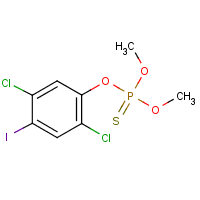Iodofenphos
Agent Name
Iodofenphos
CAS Number
18181-70-9
Formula
C8-H8-Cl2-I-O3-P-S
Major Category
Pesticides

Synonyms
Alfacron; C 9491; C-9491; Ciba C-9491; Ciba-Geigy C-9491; Compound C-9491; ENT 27408; Iodofenfos; Iodophenphos; Iodophos; Jodfenphos; Jodfenphos [ISO]; Monocron 9491; Nuvanol N; O,O-Dimethyl-O-(2,5-dichlor-4-jodphenyl)-monothiophosphat [German]; O,O-Dimethyl-O-(2,5-dichlor-4-jodphenyl)-thionophosphat [German]; O,O-Dimethyl-O-2,5-dichloro-4-iodophenyl thiophosphate; O-(2,5-Dichloro-4-iodophenyl) O,O-dimethyl phosphorothioate; O-(2,5-Dichloro-4-iodophenyl)-O,O-dimethyl phosphorothioate; OMS-1211; Phosphorothioic acid, O-(2,5-dichloro-4-iodophenyl) O,O-dimethyl ester; Trix; [ChemIDplus] UN2783
Category
Organophosphate Insecticides
Description
Pale yellow liquid or white solid; mp = 72-73 or 75 deg C; [Merck Index] Solid; [SAX] Solid; [MSDSonline]
Sources/Uses
Used as insecticide and acaricide for crops, public hygiene, homes, warehouses, and farms (especially poultry houses); [HSDB] Used as veterinary ectoparasiticide; [Merck Index]
Comments
Not irritating to the eyes of rabbits; No clinical signs or skin irritation observed in rats following 19 days of skin applications at 200 mg/kg; No symptoms observed in rats inhaling 246 mg/m3 for six hours; No evidence of neuropathy in hens fed 2000 mg/kg twice at three week interval; [HSDB] Effects in 91 day feeding studies with rats and dogs include inhibition of cholinesterase activity but no gross changes to organs; No evidence of teratogenicity, mutagenicity, or delayed neurotoxicity based on animal studies; [INCHEM PDS: Iodofenphos - 1980] “The average of two baseline respective cholinesterase activity determinations three days apart, with no exposures to enzyme inhibiting pesticides for at least 30 days, is recommended for each worker prior to exposure to cholinesterase inhibitors because of large inter-individual differences in published baseline values. To be established at least once a year. Removal from workplace exposures is recommended until the cholinesterase activity returns to within 20% of baseline.” [TLVs and BEIs]
Biomedical References
Exposure Assessment
BEI
Acetylcholinesterase activity in red blood cells = 70% of individual's baseline; Butylcholinesterase activity in serum or plasma = 60% of individual's baseline; Sample at end of shift; [TLVs and BEIs]
Vapor Pressure
8.25E-07 mm Hg
Lethal Concentration
LC (rat) > 246 mg/m3/6h
Explanatory Notes
The Guide in the Emergency Response Guidebook is for "Organophosphorus pesticide, solid, toxic."
Adverse Effects
Other Poison
Organophosphate
Diseases, Processes, and Activities Linked to This Agent
Diseases
Occupational diseases associated with exposure to this agent:
Processes
Industrial Processes with risk of exposure: